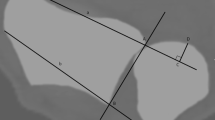Abstract
Objective
Our objective was to determine whether there is an association between pisotriquetral (PT) malalignment and acute distal radius fracture by using magnetic resonance imaging (MRI).
Methods
We evaluated 138 patients who underwent 3-T MRI of the wrists. Group A comprised 85 patients with acute distal radius fracture, and group B comprised 53 patients without trauma. PT interval and angle and pisiform excursion were measured on oblique axial and sagittal multiplanar reformats. The presence of abnormalities in the flexor carpi ulnaris tendon (FCU), pisometacarpal ligament (PML), and pisohamate ligament (PHL) were evaluated.
Results
PT interval was wider in group A on both the axial and sagittal planes (P < 0.001). Axial PT angle opened more radially in group A (P < 0.001), and the absolute value of the sagittal PT angle in group A was wider than that in group B (P = 0.006). Abnormalities in FCU, PML, and PHL were more frequently observed in group A (P < 0.001). On multiple linear regression, distal radius fracture remained significant after adjusting for the patient’s age and PT osteoarthritis.
Conclusions
Acute distal radius fracture can affect normal alignment of the PT joint, resulting in associated injuries to the primary PT joint stabilizers.
Key Points
• Acute distal radius fracture is associated with malalignment of PT joints.
• Acute distal radius fracture is associated with abnormalities of PT stabilizers.
• PT joint alignment can be evaluated with MRI with 3D sequences.
• Wrist MRI is useful for evaluating primary PT stabilizer injuries.





Similar content being viewed by others
Abbreviations
- PT:
-
Pisotriquetral
- FCU:
-
Flexor carpi ulnaris tendon
- PML:
-
Pisometacarpal ligament
- PHL:
-
Pisohamate ligament
- PTUL:
-
Pisotriquetral ulnar ligament
- TFCC:
-
Triangular fibrocartilage complex
References
Moraux A, Lefebvre G, Pansini V et al (2014) Pisotriquetral joint disorders: an under-recognized cause of ulnar side wrist pain. Skelet Radiol 43:761–773
Moraux A, Vandenbussche L, Demondion X, Gheno R, Pansini V, Cotten A (2012) Anatomical study of the pisotriquetral joint ligaments using ultrasonography. Skelet Radiol 41:321–328
Theumann NH, Pfirrmann CW, Chung CB, Antonio GE, Trudell DJ, Resnick D (2002) Pisotriquetral joint: assessment with MR imaging and MR arthrography. Radiology 222:763–770
Paley D, McMurtry RY, Cruickshank B (1987) Pathologic conditions of the pisiform and pisotriquetral joint. J Hand Surg [Am] 12:110–119
Lee JH, Yoon YC, Jee S, Kwon JW, Cha JG, Yoo JC (2014) Comparison of three-dimensional isotropic and two-dimensional conventional indirect MR arthrography for the diagnosis of rotator cuff tears. Korean J Radiol 15:771–780
Naraghi A, White LM (2012) Three-dimensional MRI of the musculoskeletal system. AJR Am J Roentgenol 199:W283–W293
Rayan GM, Jameson BH, Chung KW (2005) The pisotriquetral joint: anatomic, biomechanical, and radiographic analysis. J Hand Surg [Am] 30:596–602
Demehri S, Wadhwa V, Thawait GK et al (2014) Dynamic evaluation of pisotriquetral instability using 4-dimensional computed tomography. J Comput Assist Tomogr 38:507–512
Jameson BH, Rayan GM, Acker RE (2002) Radiographic analysis of pisotriquetral joint and pisiform motion. J Hand Surg [Am] 27:863–869
Moojen TM, Snel JG, Ritt MJ, Venema HW, den Heeten GJ, Bos KE (2001) Pisiform kinematics in vivo. J Hand Surg [Am] 26:901–907
Zanetti M, Saupe N, Nagy L (2007) Role of MR imaging in chronic wrist pain. Eur Radiol 17:927–938
Beckers A, Koebke J (1998) Mechanical strain at the pisotriquetral joint. Clin Anat 11:320–326
Goldfarb CA, Yin Y, Gilula LA, Fisher AJ, Boyer MI (2001) Wrist fractures: what the clinician wants to know. Radiology 219:11–28
Vasilas A, Grieco RV, Bartone NF (1960) Roentgen aspects of injuries to the pisiform bone and pisotriquetral joint. J Bone Joint Surg Am 42:1317–1328
Blum AG, Zabel JP, Kohlmann R et al (2006) Pathologic conditions of the hypothenar eminence: evaluation with multidetector CT and MR imaging. Radiographics 26:1021–1044
Helal B (1978) Racquet player's pisiform. Hand 10:87–90
Kofman KE, Schuurman AH, Mulder MC et al (2014) The pisotriquetral joint: osteoarthritis and enthesopathy. J Hand Microsurg 6:18–25
Acknowledgments
The scientific guarantor of this publication is Hye Jin Yoo. The authors of this manuscript declare no relationships with any companies, whose products or services may be related to the subject matter of the article. The authors state that this work has not received any funding. No complex statistical methods were necessary for this paper. Institutional Review Board approval was obtained. Written informed consent was waived by the Institutional Review Board. Methodology: retrospective, observational, performed at one institution.
Author information
Authors and Affiliations
Corresponding author
Rights and permissions
About this article
Cite this article
Chae, HD., Yoo, H.J., Hong, S.H. et al. Assessment of pisotriquetral misalignment with magnetic resonance imaging: Is it associated with trauma?. Eur Radiol 27, 3033–3041 (2017). https://doi.org/10.1007/s00330-016-4624-8
Received:
Revised:
Accepted:
Published:
Issue Date:
DOI: https://doi.org/10.1007/s00330-016-4624-8




